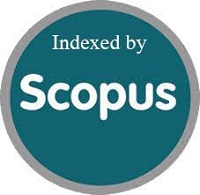Validity of Marital Conflict Resolution Scale Using Reflective Measurement Model of PLS-SEM
DOI:
https://doi.org/10.15408/jp3i.v9i1.15449Keywords:
penyelesaian konflik pernikahan, marital conflict resolution, constructive resolution, destructive resolution, reflective measurement model, penyelesaian konstruktif, penyelesaian destruktif, model pengukuran reflektifAbstract
Abstract
This research describes the validity of marital conflict resolution scale that formulated from Gottman theory about marital conflict resolution. Marital conflict resolution scale presented to 255 married women in Makassar city. Consisting of 26 items, marital conflict resolution scale there are two dimensions consisting of constructive resolution and destructive resolution. Constructive resolution consist 11 items and destructive resolution consist 15 items has had five choices of the answer. The answer ranging from strongly agree (1 score) to strongly disagree (5 score) for favorable item, and unfavorable items get the opposite score. Validity of marital conflict resolution scale is tested using the reflective measurement model of PLS-SEM. The results of the outer model and the structure or inner model have shown the original sample estimate ≥ 0.50, this means that each indicators can represent both dimensions.
Abstrak
Penelitian ini menguraikan mengenai validitas skala penyelesaian konflik perkawinan yang dirumuskan dari teori Gottman tentang penyelesaian konflik perkawinan. Skala penyelesaian konflik perkawinan diberikan kepada 255 responden wanita menikah di kota Makassar. Terdiri dari 26 item, skala penyelesaian konflik perkawinan memiliki dua dimensi yang terdiri dari penyelesaian konstruktif dan penyelesaian destruktif. Penyelesaian konstruktif terdiri dari 11 item dan penyelesaian destruktif terdiri dari 15 item memiliki lima pilihan jawaban. Jawaban mulai dari sangat setuju (1 skor) hingga sangat tidak setuju (5 skor) untuk item yang menguntungkan, dan item yang tidak menguntungkan mendapatkan skor yang berlawanan. Validitas skala penyelesaian konflik pernikahan diuji menggunakan model pengukuran reflektif PLS-SEM. Hasil outer model dan struktur atau inner model menunjukkan original sample estimate ≥ 0,50, ini berarti bahwa masing-masing indikator dapat mewakili kedua dimensi.
References
Bermudez, J. Maria, Reyes, Nenetzin A. & Wampler, Karen S. (2008). Conflict resolution styles among latino couples. Journal of Couple & Relationship Therapy ISSN: 1533-2691 (Print) 1533-2683 (Online) Journal homepage: http://www.tandfonline.com/loi/wcrt20.
Chapin, Lori A. Russell. Chapin, Theodore J. & Sattler Linda G. (2001). The relationship of conflict resolution styles and certain marital satisfaction factors to marital distress. The Family Journal: Counseling and Therapy for Couples and Families, 9(3), 259-264. Sage Publications. Deutsch, Morton.
Coleman, Peter T. & Marcus, Eric. (2006). The handbook of conflict resolution; theory and practice. San Francisco. Jossey-Bass A Wiley Imprint.
Gottman. John M. (1994). The seven principle for making marriage work. New York. Crown Publishers, Inc.
Gottman. John M. & Silver, Nan. (2015). The seven principle for making marriage work. New York. Harmony books. Crown Publishers, Inc. www.crownpublishing.com.
Grasiano, M, Anthony, & Raulin, L., Michael. (2000). Research methods: a process of inquiry. New York. Allyn and Bacon.
Hair, Joseph F. Hult, G. Tomas M. Ringle, Christian M. Sarstedt, Marko. (2017). A primer on partial least squares structural equation modeling (PLS-SEM) [2nd ed.]. United States of America. SAGE Publications, Inc.
Hair Jr, Joseph F. Black, William C. Babin, Barry J. Anderson, Rolph E. (2019). Multivariate Data Analysis, Eighth Edition. Canada. Cengage Learning EMEA.
Hair Jr, Joe F. Sarstedt, Marko. Hopkins, Lucas Kuppelwieser, Volker G. (2014). Partial least squares structural equation modeling (PLS-SEM): An emerging tool in business research. European Business Review, 26(2), 106-121, https://doi.org/10.1108/EBR-10-2013-0128. Permanent link to this document: https://doi.org/10.1108/EBR-10-2013-0128.
Halford and Petch., Creedy., & Gamble. (2011). Intimate partner violence in couples seeking relationship education for the transition to parenthood. Journal of Couple & Relationship Therapy, 10:152–168, 2011 Copyright © Taylor & Francis Group, LLC ISSN: 1533-2691 print/1533-2683 online DOI: 10.1080/15332691.2011.562835.
James, Adrian L, & Wilson, Kate. (2002). Couple, conflict, and change: social work. London. The Taylor & France e-Library.
Lim, Ben K H. (2000). Conflict resolution styles, somatization, and marital satisfaction in Chinese couple: moderating effect of forgiveness and willingness to seek profesional help. Dissertation. Texas. Texas Tech University
Miller, Rowland S. & Perlman, Daniel. (2009). Intimate relationship. Fifth Edition. New York. McGraw Hill.
Muin, Sitti. Murdiana. (2014). Penyelesaian Konflik perkawinan pada perempuan bercerai dan perempuan menikah di kota Makassar. Proceeding Temu Ilmiah Nasional. Surabaya.
Neff, A. Lisa & Karney, R Benyamin. (2002). Self evaluation motives in couple relationship: a model of global enhancement and spesific verification. Noller dan Feeney (Editor). Understanding Marriage. New York. Cambridge University Press.
Umubyeyi, Beatrice and Mtapuri, Oliver. (2019). Approaches to marital conflict resolution: a perspective of democratic Republic of Congo migrants living in Durban, South Africa. Journal of Family, 40(8), 1065–1085. sagepub.com/journals-permissions. DOI: 10.1177/0192513X19833092 journals.sagepub.com/home/jfi..



